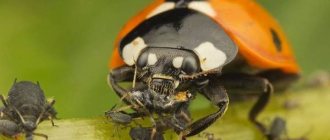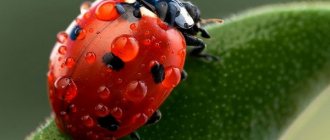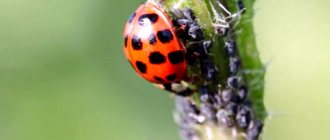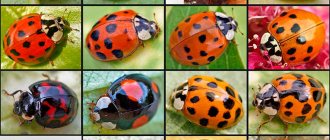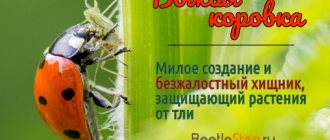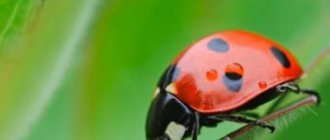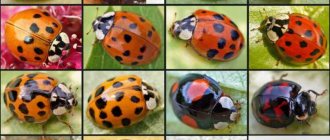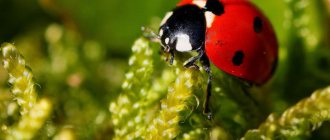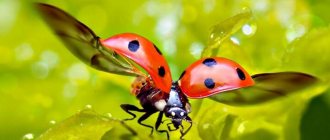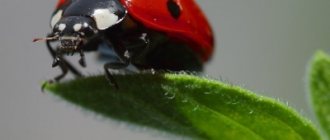Beetles from the ladybird family are clearly visible on leaves, flowers and grass. Their convex red and black bodies flash among the greenery of parks, gardens and vegetable gardens. The insect's attractive coloration is actually a warning. In case of danger, the beetle releases a poisonous liquid. It is not harmful to humans, and birds do not risk hunting small bugs. Attentive fauna lovers will notice that the pattern on the back of ladybugs differs in the number of dots. The number of black spots on the elytra ranges from 2 to 28. The seven-spotted ladybug is the most common species that is found in parks, fields and gardens.
Where does this insect live?
Of all the species, the most famous is the seven-spotted ladybug. It can be found in all European countries, except for the northern zones. In addition, this bug is found in North Africa and even in Japan.
But in North America, the insect could not bring much benefit. Despite the fact that it was brought to the continent, the red ladybug could not take root. There are only a few species left in North America that do not produce the desired results.
This insect prefers to live in grass groves, as well as in forest plantations, meadows, fields, plains and ravines. It is during the autumn period that ladybugs form large columnar flocks. The number of accumulated insects reaches several thousand.
Lifestyle
Young beetles constantly move between potato beds, eggplants, tomatoes and pumpkin crops. With the onset of autumn frosts (late September), they begin to look for places for wintering: dry leaves, crevices, under-roof spaces of outbuildings. Beetles can also hide under the bark of old trees and burrow into the soil.
With the beginning of spring, potato ladybugs wake up, leave their wintering grounds and begin a new growing season.
The diet of the epilyanha consists of a variety of economic crops:
- Potato;
- Tomatoes;
- Eggplant;
- Watermelons;
- Pumpkin;
- Soy;
- Cucumbers;
- Sunflower;
- Corn and others.
Insects cause the greatest damage to potatoes. This is due to the fact that the period of feeding of epilyanchi larvae coincides with the phase of its tuberization. As a result, potato yields can decrease by 20-40%. In addition, the attack of the potato borer also negatively affects the taste of root crops - the starch and sugar content decreases.
The harmful effect of beetles and larvae is not only the destruction of tops, but also the fact that due to the violation of protective covers, plants begin to suffer from viral and bacterial diseases.
Description of this species, developmental features
Initially, the ladybug has the appearance of a larva, the size of which does not exceed 1 mm. It only takes her one month to move to a new level of development.
Then it already has a size of 8 to 10 mm. The body of the larvae is usually gray in color, but the head is yellow. The spots on the sides of this insect are also of the same color. The body has segments on which black spines with hairs can be seen.
In order to get food, such a larva can climb to a height of up to 12 m. During the day, to be full, it needs to absorb about 100 adult aphids or 300 of its larvae. After a month, the larva enters the pupal stage. It takes about 12 days for a ladybug to fully develop and mature. But it all depends on the air temperature: the warmer it is, the faster the pupa will turn into an adult ladybug.
Nutrition
When the temperature rises to 13 degrees Celsius, most of the ladybugs already cover shrubs, grass meadows, grain crops, forest plantations and other green spaces.
They are very fond of alfalfa and barley fields. The activity of beetles increases due to a favorable climate and the appearance of additional food, because their favorite delicacy, aphids, appears on shrubs and grasses.
Just for the development of one larva, 1000 aphid insects are needed. The daily diet of an adult beetle is up to 200 insects.
These peaceful creatures for humans are very dangerous for living organisms of their size and type and are voracious predators. But even with their carnivory they bring considerable benefits to humans. After all, those whom they eat are known as malicious pests and parasites.
What do ladybugs eat? They destroy hordes of aphids (an adult can eat about a hundred of them in a day), eat other insects, their eggs, as well as caterpillars, pupae and even butterflies.
Therefore, in order to save farmland, ladybugs are deliberately bred and dropped from airplanes in large numbers. If they lack food, they happily turn to the eggs of a well-known pest of potato plantings - the Colorado potato beetle.
But there are species of these insects whose diet includes only plant foods: flowers, leaves, pollen, and in some cases, plant fruits and mushrooms. They really sometimes become a big problem, causing damage to fields and crops growing on them.
However, such species are more common in southern Asia. In Russia they exist (for example, alfalfa and pointless ladybugs), but they are not common.
There are pests similar to the ladybug, epilyachna
It is also called the potato ladybug. It differs from the described insects in the dull colors of its outfit, the abundance of spots (there are as many as 28 of them), and upon closer examination you can see thin whitish hairs on the body.
Description of the adult
The body, wings and abdomen of an adult insect are black. The wings are mainly red or orange in color with spots characteristic of this insect (7 points). For this reason, the seven-spotted ladybug was named so. Three points are on one red wing, and the same number on the second. But the 7th spot can be seen near the beetle’s head.
Adult ladybugs begin to appear outside in the first half of June, when it begins to warm up. In places where the heat comes faster, you can find ladybugs in May.
They eat aphids and can eat up to 60 adult pests in a day. A ladybug lives from several months to two years. The description of the larvae indicates that for growth and rapid development they eat much more aphids than adults.
Lifestyle and habitat
Insects lead a solitary life, with the exception of the mating period and wintering. They are found in large numbers on forest edges and feel comfortable in meadow communities and in gardens.
Ladybugs in most cases benefit people by destroying aphids. There are known cases of deliberate breeding of these insects and their movement with the help of aviation to areas to control field pests.
Nature has reliably protected this insect from the encroachments of ill-wishers. The ladybug is so bright that it can scare away predators. But it’s not just the overly conspicuous coloring that plays a role here.
A good defense against potential attackers is the special natural liquid secreted by such insects in anticipation of danger. This is what is commonly called cow's milk.
In case of danger, the ladybug secretes a specific liquid
It has an unpleasant odor, is poisonous, has a yellow tint, and contains cantharidin. This milk repels all insidious predators, even the formidable tarantulas. And almost no one in nature dares to touch the harmless ladybug.
However, there is still a parasitic insect from which such creatures have no protection. These are dinocampuses. They gradually kill the cows and their pupae by placing their eggs there, which destroy them as they develop.
The habitat of ladybugs depends on their variety. Some of them are perfectly adapted to live in meadows near rivers and streams; others can only exist in trees. There are known varieties that settle only on certain types of flora, for example, aquatic plants, reeds, sedges, field grasses; some look for places where aphids accumulate because they feed on them.
In general, different types of ladybugs spend the cold season in their own way. Those of them that have adapted to life in temperate areas and are sedentary usually choose convenient shelters from winds and frosts: terraces, garages, barns, houses.
Sometimes, in search of shelter, they unite in groups, even large communities, the number of individuals in which amounts to tens of millions. In winter, they can hide in piles of leaves, bark and rocky debris.
As soon as these insects manage to recover from the vicissitudes of winter, migration or hibernation, instinct begins to push them to reproduce their own kind. And they begin this process somewhere in the middle of spring.
Formed specimens (usually these are individuals at least 3 months or six months old) are preparing for mating. Males, obeying the natural program, find partners based on their unique smell. It comes from specific secretions of female individuals.
Next, the females attach their eggs, tapered at the ends and oval in shape, to the leaves of the plants on the back side. Cows deliberately choose those places where there is a sufficient supply of food for future offspring, most often in the epicenter of colonies of insects suitable for food, for example, aphids.
Cow eggs are white, orange or yellow in color, and their number can reach up to four hundred in one clutch.
A ladybug's clutch can contain several hundred eggs.
It’s sad, but having done its job, the female dies. But life goes on, because the eggs soon (no later than two weeks) hatch into flat or oval larvae.
At first, the nutrients contained in the shell of their own egg are quite sufficient for them to live. But after a few days, the future cow begins to exterminate pests. One larva can consume up to fifty aphids per day.
Ladybug larvae also feed on aphids
And a gathering of them quickly makes short work of entire colonies. One or two months pass after saturation and growth, and then another stage begins - pupation.
Reproduction
A female ladybug can lay about 1,000 eggs throughout her life stage.
The eggs of these insects are oval. They measure up to 1.2 mm. The color of the laid eggs is orange. The shape of the masonry generally looks like a small pile. At one time, an adult female can lay from 20 to 90 small eggs. Basically, such clutches are located in safe places, that is, under leaves, blades of grass, and at the base of branches.
A large number of ladybugs can be observed precisely at the end of summer, when two generations of beetles have already hatched and developed. The larvae do not overwinter, since only adults can survive this period.
What does this insect eat and what benefits does it bring to humans?
The seven-spotted ladybug is a predator. Moreover, at any stage of its development, it feeds exclusively on other bugs. It mainly eats various types of aphids, which live on all kinds of plants and trees. In addition, the bug eats the eggs of other insects: butterflies, moths, etc.
This beetle can most often be observed on fruit trees, currant bushes, as well as pine, aspen and bird cherry. The presence of such plants in the regions of our country indicates a large number of these insects.
Many farmers, in order to preserve their crops, use ladybugs as a healer and get rid of aphids. On a hot day, the number of these red bugs increases, especially near ponds, roads and sun-heated stones.
Notes
- ↑
- Striganova B. R., Zakharov A. A.
Five-language dictionary of animal names: Insects (Latin-Russian-English-German-French) / . - M.: RUSSO, 2000. - P. 140. - 1060 copies. — ISBN 5-88721-162-8. - ↑ (inaccessible link)
- ↑ Key to insects of the Far East of the USSR. T. III. Coleoptera, or beetles. Part 2 / under general. ed. P. A. Lera. - L.: Nauka, 1992. - P. 363. - 704 p. — 1400 copies.
- ↑ Polyakova G.M.
Key to the beetles of the tribe Coccinellini (Coleoptera, Coccinellidae) of the Middle Volga region / edition editor Florov D.N. - Kuibyshev State Pedagogical Institute named after V.V. Kuibyshev, 1969. - 37 p. — 2000 copies. - ↑
- Kent JT
Hering`s Guiding Symptoms Of Our Materia Medica. - New Delmi: B. Jain Publishers (P) LTD., 2003. - Vol. II. - P. 646. - 877 p. — ISBN 81-8056-318-9. - ↑
- Alfred G. Wheeler Jr.
Biology of the Plant Bugs (Hemiptera: Miridae). Pests, Predators, Opportunists. - New York, Ithaca: Cornell University Press, 2001. - P. 286. - 507 p. — ISBN 0-8014-3827-6.
What do gardeners think about the seven-spotted ladybug? How to attract this insect?
Is the seven-spotted ladybug a pest or not? Many gardeners, of course, will answer no. Thanks to this small insect, it is possible to preserve a significant amount of the crop. Aphids, which eat and damage many plants, are the ladybug's most important food source.
Those people who prefer not to use chemical compounds to kill pests on their plants believe that the ladybug is the best helper. But in order for the benefits of this insect to be more tangible, you need to maintain appropriate conditions in your area for the comfortable life of these red insects. To do this, you should not destroy all the aphids in the spring, and especially not resort to harmful chemicals, because then the ladybug will not come. It is better to leave a few aphids so that our insect can eat. This will attract ladybugs and they will stay in your area for a long time, helping to control numerous pests.
Ways to combat potato ladybugs
It is impossible to completely get rid of overwintered epilyachna and its larvae without the use of pesticides. But there are prevention methods that can reduce the population size of the potato ladybug:
- it is necessary to follow the rules of crop rotation;
- It is undesirable to set up potato plantations near the edge of the forest;
- You need to carefully weed out the weeds in and around the area. After harvesting, all tops and other plant residues are burned;
- Late autumn plowing allows you to destroy at least some of the cows that have prepared for the winter;
- The potato ladybug cannot stand the smell of mint. Therefore, you can sow mint around the plots;
- If the area is small, it is recommended to collect the masonry manually.
During egg laying, female pests exhibit increased sensitivity to odors. To scare away epilyachna, you can treat plantings of potatoes and other nightshades with one of the folk remedies:
- dust the tops with wood ash (at the rate of 3–5 kg per hundred square meters);
- spray the plants with garlic infusion: chop 200–300 g of garlic arrows or old heads, add 10 liters of water, leave for 2–3 days, strain before use;
- Pour 1 kg of wormwood into 2–3 liters of water and boil for 15 minutes. Strain the cooled broth and add water to 10 liters.
Potatoes are treated with such means in early June, and then, if necessary, 1-2 more times with an interval of 2 weeks.
